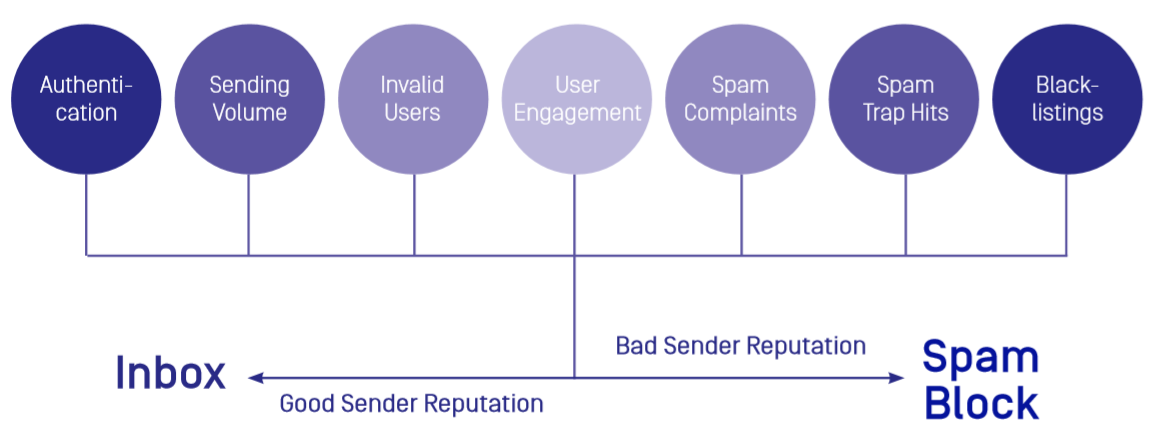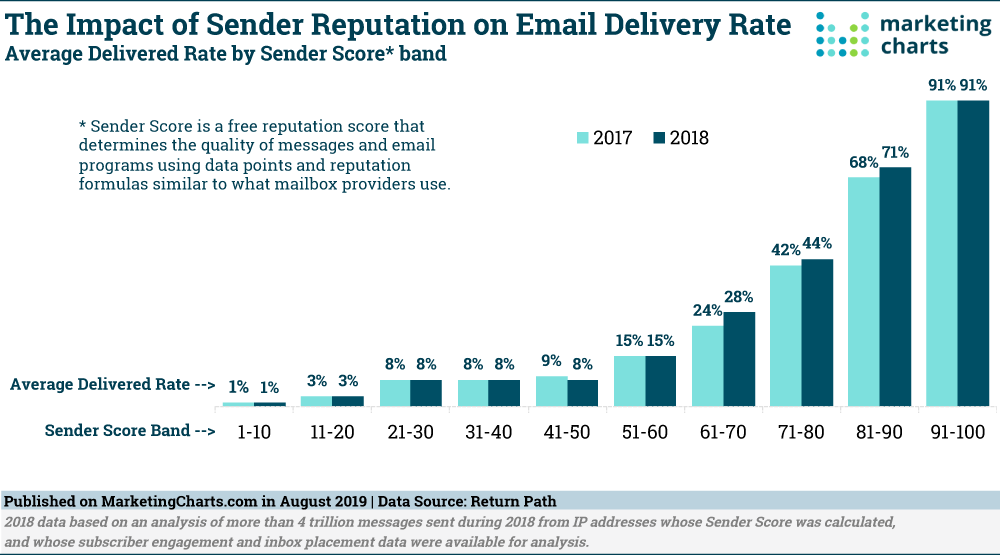Domain reputation is how your internet service providers (IPs) perceive your domain and is one of the key components that impact the health of your deliverability.
As a business owner, you probably already know that your company’s brand is your most important asset. While building credibility and trustworthiness is a surefire way to get recognized by customers, the key factor in creating any branding strategy is a company’s domain reputation.
What’s tricky is that your domain reputation is earned over time. It’s not built overnight and is determined by many factors, such as engagement, spam traps, and bounce rates. Fortunately, there are several things you can do to assess and improve your domain reputation and, in turn, improve deliverability.
This blog post will cover the best practices for maintaining domain reputation, so your branded domain isn’t affected. By the end of the article, you’ll be equipped with the knowledge and understanding of how domain reputation affects your email deliverability and what you can do to improve it.
What Is Domain Reputation?
Domain reputation refers to the health or state of your domain as determined by Internet Service Providers (IPs) and Mailbox providers, who then decide where your email should land–the recipient’s inbox or the spam folder.
Since email marketing is still considered one of the most effective ways to reach customers online, you should ensure you’re getting it right. One of the basic factors that impact the health of your deliverability is, in fact, low domain reputation.
You can think of it like the reputation we build for our brands; it’s not only affected by what you do but also by what you’ve done and who you’re associated with. It’s essentially how credible and trustworthy your brand or website is, according to search engines.
For instance, if you’re a company that focuses on sports nutrition and gym fitness, you will have to build a strong reputation. This way, more people will trust and advocate for your recommended diet.
In technical terms, though, domain reputation is the overall health of your branded domain as interpreted by ISPs such as Gmail, Yahoo, and AOL.
It matters because a good sender reputation increases the deliverability of your emails, which increases brand recognition. At the same time, a bad domain reputation does the opposite–low deliverability ROIs.
Most importantly, though, you’re at higher risk of having your emails classified as spam and affecting your email campaigns performance which means:
- Your business email’s open rate will drop
- Your engagement and conversions will drop
- A poor reputation among your valuable customers
This is why it’s important to check it regularly and fix all issues that may weaken it.
How Does Email Domain Reputation Work?
While we already know that ISPs and Mailbox providers are primarily responsible for determining our email’s deliverability status. But on a scale from 1-100, how do they calculate this?
While each ISP is different, they all have their algorithm, which weighs several factors when determining a domain reputation. Some of these factors include:
- read rate
- open rate
- reply rate
- spam rate
- Average spam rate
- Speed complaint rate
- Spam placement rate
- Deleted before the reading rate
Notice how all these factors are based on email recipient behaviour. So, if your domain reputation gets too bad, it can be difficult to recover.
6 Factors Affecting Domain Reputation
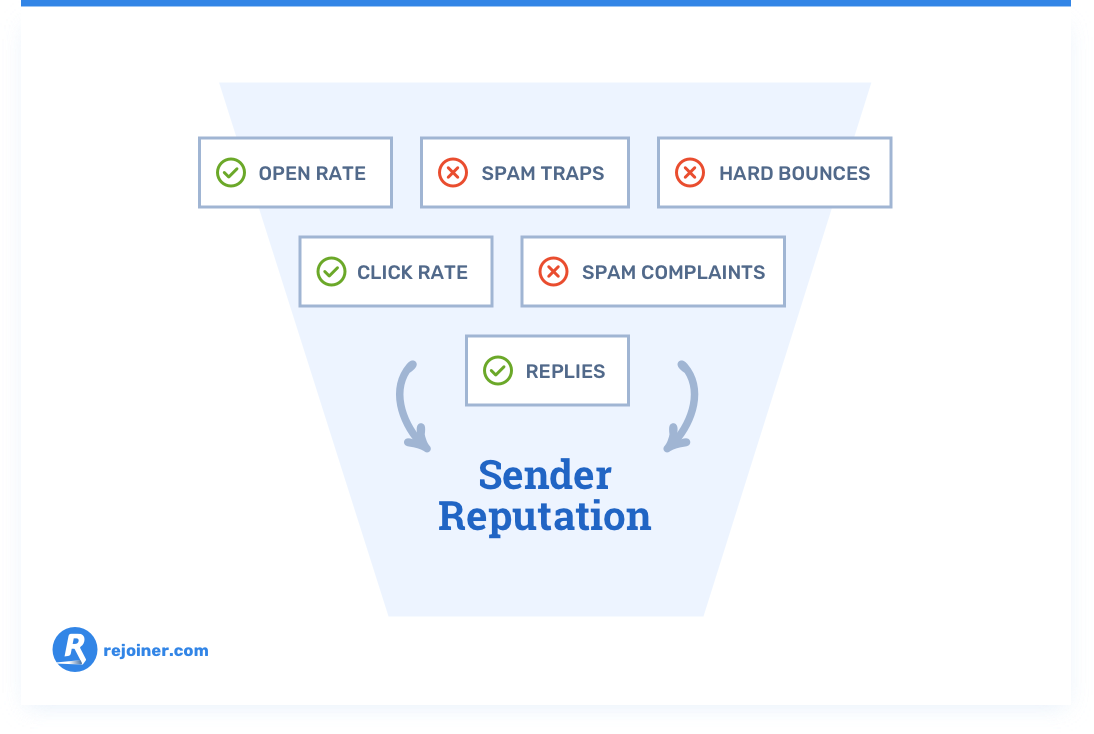
Several factors can contribute directly to a poor domain reputation, which are:
1. Poor IP Reputation
Both IP and ISP Reputation are different concepts but are used interchangeably. IP reputation focuses on whether the email originating from your IP address contains any harmful SPAM content. For instance, if an email server’s IP address sends authentic, spam-free emails, it gets a positive reputation score.
However, If you’re using a shared IP, your domain reputation will continuously be down the line. Several companies or senders use a shared IP. Hence, bad email practices from others who share the same IP address will directly affect the domain reputation of your sending domain. But, at the same time, if your adjacent senders are doing well, you will likely benefit. In this case, your email service provider plays a crucial role.
2. Blacklisting
Email blacklisting can decrease your domain’s reputation considerably. For one, blacklisting is used as a method to flag suspicious behaviour. It occurs when email recipients mark the email as spam or junk. If a particular email receives many spam complaints, your domain risks being blacklisted.
If your website is blacklisted, you have been flagged as untrustworthy or shady, which can cause your domain reputation to hit. In this case, you can use a security plugin to improve your reputation and prevent blacklisting. Also, when building email lists, be sure to leverage consent pop-ups, so the user is aware that emails are coming their way. Unwanted emails get sent to spam, and you don’t want that.
Moreover, even if you successfully get the recipient to open the email but if it directs them to a shady website, you’re still in trouble. In this case, you’ll need credible hosting for the website you’re directing the recipients to. If it’s an eCommerce site, choose a good Shopify or WooCommerce host.
Many cyber companies keep track of IP addresses that send spam emails. These blacklists help ISP and Mailbox providers identify and block mail from suspicious senders. As a result, email blacklisting adversely affects your email sending.
3. Email Content
The quality of your content also has a significant impact on email performance. Your domain reputation decreases if your emails contain sketchy words or phrases. Your email provider may also filter an email and flag them as spam for having many exclamation marks or catchy subject lines that make ISPs suspicious.
Your content is also affected by ineffective email outreach. If you’re targeting the wrong audience or addressing too many people at once, your emails are making an impression that they don’t matter to the recipient.
When you do that, your emails are most likely not read since they won’t be relevant to the person who received them. In this case, personalizing your email can help maximize list building phase and email delivery rates.
A basic example is an email requesting a callback but not leaving the correct information. Even if the email reaches the intended person, it won’t help. Your ISP will then make a decision, based on your recipient’s open and speed rate, to develop a reputation for your domain.
4. Lack Of Consistency
When you send transactional or marketing emails, it’s crucial to stay consistent. Let’s say you send 100 emails per week and suddenly switch to 5000. ESPs could mark this activity as suspicious. Likewise, If you send emails too frequently, people will more likely dismiss and ignore them, affecting your domain reputation.
The key is slowly growing your subscriber base according to how your business grows. As your domain’s reputation depends on consistency and the volume of emails sent, you should focus on finding the right frequencies and timings for your emails.
5. Authentification
Authentication protocols, such as SPF, DKIM, or real-time email validation API, can go a long way in confirming your legitimacy as a sender to email clients. In other words, domain authentication allows email providers’ ISPs to know that you’re the one sending emails. You can think of it as your domain ID.
They help ensure that the email comes from a legitimate source and not from a spammer. Setting up these protocols can do wonders in increasing the trustworthiness of your email domain in the eyes of ESPs, and improving your domain reputation.
6. Engagement
The time and money you spend on email marketing are wasted if your email doesn’t reach the recipient’s inbox or if they don’t bother to open it. Unfortunately, that will happen if you let your engagement tank.
Just like businesses use slideshow videos to hold the employee’s attention during presentations, your emails need to be as captivating or even more. It is in your best interest to ring every ounce of performance from your email marketing campaigns by using videos and getting your timing right.
ESPs want to make sure you’re sending people messages that they want. Thus, a lack of engagement or negative engagement shows that you’re not sending content people want. As a result, they will cause reputation issues.
Whether your engagement is suffering from a lack of catchy subject lines or relevant information, trying to find out how these shifts have impacted your engagement can take time and effort. By streamlining assets with digital asset management software, companies can enhance their email marketing campaigns, deliverability, and reputation by easily seeing the results of campaigns and keeping track of what’s taking place at each step.
How To Monitor Domain Reputation
Now, let’s look at how domain reputation management helps to gain clarity on your email’s performance. Since domain reputation acts just like a scoreboard, it ranges from 0-100, with each domain having a specific score that can either lessen or improve your deliverability. It’s crucial to know how to check your domain reputation.
In this case, you are identifying. There are a variety of tools for performing a domain reputation check. If you’re having email deliverability problems, you can check your domain reputation to find out if that’s the issue. The key is to be proactively engaged in learning how to fix your domain reputation significantly.
Here are some free tools to monitor and track the reputation of your domain: We’ll go over what they are, what they do, and what they cost.
A. Google PostMaster Tools
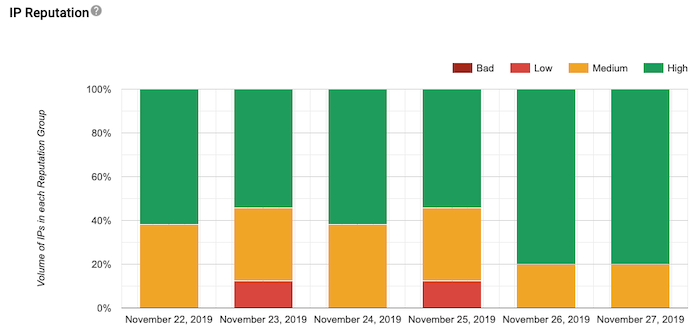
Hundreds and Millions of businesses and consumers use Google inboxes. That’s why you need to manage your email delivery reputation at Google to ensure your email is viewed positively by Gmail inboxes.
Google offers a free check tool called Google PostMaster Tool, which helps organizations understand why their emails were sent to SPAM. In addition, it helps in assessing your domain and IP reputation, along with other key metrics such as average score and spam rate. Most importantly, it will tell you what Google thinks of your domain reputation (Good, Medium, Low, or Bad).
In short, the postmaster tool is extremely useful when monitoring and debugging deliverability issues of all types.
B. Sender Score
Your sender score is much like a credit score used to measure your creditworthiness, but for email: It’s a measure of your reputation. The sender score gives you a simple score ranging from 0-100. The higher the score, the greater your email deliverability rate and reputation.
Besides helping you measure your score, it also offers solutions on how to improve your reputation if your score is low and has a bad email reputation. Overall, it’s a free email reputation service that provides a sign of the credibility of an email sender’s IP address.
C. Talos Intelligence
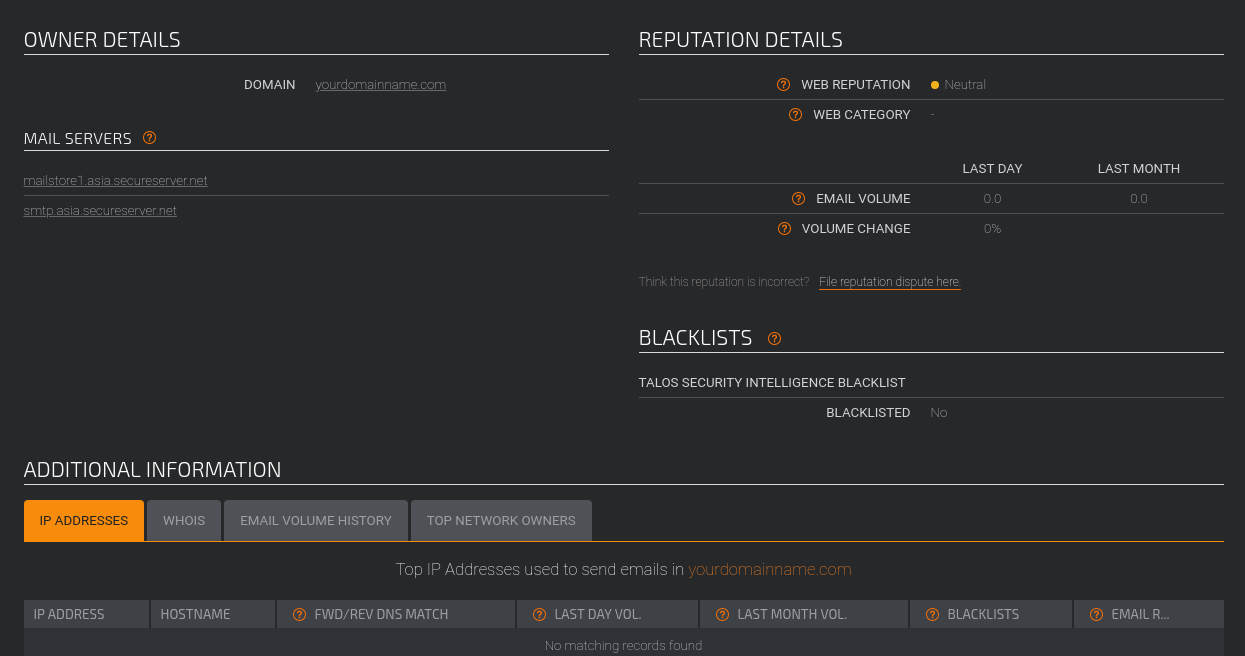
Talo Intelligence is another free tool, and among the most extensive tools to keep a lookout for your sender score, domain, and IP reputation.
Cisco created this system as a way to monitor your online reputation over several IPs. (Good, Neutral, or Poor) This makes it useful in spotting any major problems and identifying additional email volume and volume history data.
2 Important Considerations For Email Marketers
When you’re starting, choosing the right domain can make all the difference in helping you build your domain’s reputation. Again, gaining a solid reputation is a slow and steady process. It involves ensuring your domain name fits the right audience to increase engagement and deliverability.
1. Which Type Of Domain To Choose
Deciding to register a domain name should be done promptly. Instead, careful deliberation and research should be applied as it might be your most important decision for your website’s reputation. Since your brand name says everything about you, your values, your identity, and what you promise to deliver, your domain name shouldn’t be different.
A new business venture should select a domain name that parallels the brand’s name to direct customers to your site without any doubt. Overall, a strong domain name that represents your brand will entice your customers and separate your business from others in the industry.
2. How To Use A Domain To Reinforce Your Brand
A common myth people believe is that your domain name should contain keywords. Keywords are words related to the product or services used in a domain name. While using keywords in your domain can help reinforce your brand or bring traffic to your site, it’s not the surefire way to continue. Google has now changed its algorithm to downplay the strict use of keywords and rewards sites with a strong sense of branding instead.
When starting a company, creating a valuable and brandable domain name is crucial. That is how people will know who you are and what you represent. The bottom line is that it should be clear, understandable, and easy to spell and write.
3 Ways To Improve Domain Reputation
Domain reputation is earned over time hugely in regards to the factors we just considered: IP reputation, content, and engagement – which when combined, paint a picture of your domain to ISPs.
However, you can take a few more steps to improve your reputation moving forward.
I. IP Address Warmup: Domain Age
If you have a new IP Address, it probably has no reputation or record yet. So how do you get ISPs to trust you? While you might think it’s a good idea to start sending out lots of emails from a brand new IP address, ESPs and IPs will not like it and mark it as spammy behavior. This is why it’s crucial to start building a positive domain immediately. The last thing you want to do is start at a disadvantage because you made a silly mistake.
Instead, what you can do is start by sending small amounts of messages to your most engaged recipients. This high engagement builds your domain reputation much more quickly. You can start with 100 and move up until you hit your maximum number of sends each day. This way, you will have a consistent process to prevent ISPs from becoming suspicious and flagging your domain.
II. Leverage Segmentation To Send Targeted Emails
This is a common email strategy and an even better marketing ploy. Segmenting your audience and sending targeted emails using reputable email marketing software like MailChimp, Klaviyo, and MailChimp alternatives is one of the most effective ways to increase deliverability and drive more sales. You can segment subscribers for health and safety equipment like facemasks and surgical instruments by using this software, and in turn, increase your deliverability.
A marketing team can divide groups based on geographical location, subscriber’s age, interests, and gender identifications. Developing an email segmentation strategy based on their personas will have content tailored to their journey and what it is like to convert them. This way, you can get important information from the right audience. For instance, if you’re a company looking to include TikTok marketing in your strategy to engage your users, you can quickly ask a specific age group of email recipients what they think about it. This way you are more likely to get responses back because your email content fits the right audience of users.
III. Domain Classification
Classifying your domains can significantly affect your domain’s reputation potential. When registering your domain, you should classify it to a specific industry. For example, if your business is classified under the digital marketing category, but you’re sending emails related to computer software, then that would be inconsistent with the domain type. As a result, ISPs might flag your domain.
Similarly, email consent is another aspect of domain classification that can’t be overlooked. Take this as an example: if someone signs up to attend a job fair, but later, you don’t send them a message about the location or date, you’ve lost that consent. This is why your targeted industry and content are so important.
Conclusion
Monitoring your domain health isn’t a one-time process. It involves consistent nurturing to see desired results. No matter what, establishing a high domain reputation is foremost in your deliverability.
When starting, picking a suitable domain name and slowly building your email list is crucial for ISPs to think you’re credible. In addition, monitoring your domain will help you identify what is affecting your reputation and how you can improve it. By using some of the tools and practices listed on this page, you can improve your domain’s reputation, and in turn your deliverability.
Author Bio

Burkhard Berger is the founder of Novum™. Follow Burkhard on his journey from $0 to $100,000 per month. He’s sharing everything he learned in his income reports on Novum™ so you can pick up on his mistakes and wins.

